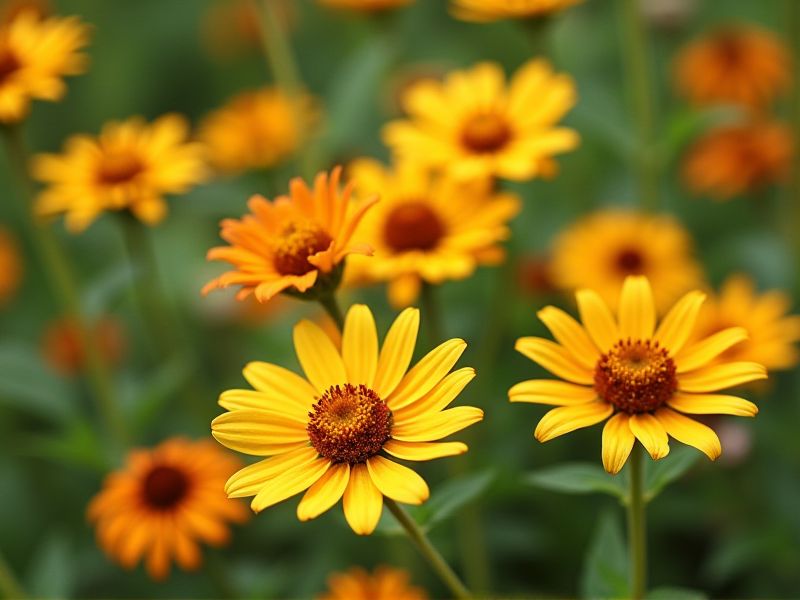
Drought-tolerant plants that bloom in summer include the vibrant Lantana, known for attracting butterflies to your garden. The hardy Russian Sage, with its silvery foliage and purple flowers, thrives in arid conditions, enhancing landscape aesthetics. Agastache, or hummingbird mint, offers a fragrant display with long-lasting blooms that draw in pollinators, making it ideal for low-maintenance gardens. Coneflower, or Echinacea, not only withstands dry spells but also provides medicinal properties alongside its striking daisy-like flowers. Consider incorporating these resilient species to enjoy a flourishing summer garden while conserving water resources.
List of some Drought-tolerant plants that bloom in summer
- Lavender (Lavandula)
- Coneflower (Echinacea)
- Blanket Flower (Gaillardia)
- Russian Sage (Perovskia atriplicifolia)
- Yarrow (Achillea)
- Black-eyed Susan (Rudbeckia)
- Stonecrop (Sedum)
- Catmint (Nepeta)
- Verbena (Verbena)
- Gaura (Oenothera lindheimeri)
Important things about Drought-tolerant plants that bloom in summer
Water-Efficient Growth
Drought-tolerant plants that bloom in summer are ideal for water-efficient gardens, providing vibrant colors while minimizing water usage. Varieties such as Agastache, Echinacea, and Lavandula thrive in dry conditions, making them perfect for eco-friendly landscaping in arid climates. By incorporating these resilient species, you can enhance biodiversity, attract pollinators, and reduce the need for irrigation. Your garden can flourish with reduced environmental impact, promoting sustainability while enjoying a burst of summer blooms.
Heat Resistance
Drought-tolerant plants that bloom in summer, such as succulents, lavender, and ornamental grasses, are ideal for heat-resistant landscaping. These plants are adapted to survive in high temperatures and low water conditions, making them perfect choices for arid climates. Selecting varieties like Rudbeckia or Echinacea not only adds vibrant colors to your garden but also ensures minimal water usage. By incorporating these resilient plants, you can create a sustainable and visually appealing outdoor space that thrives even during hot summer months.
Full Sun Requirements
Drought-tolerant plants that bloom in summer thrive in full sun, showcasing vibrant flowers while conserving water. Varieties such as lavender, coneflower, and succulents like agave not only add color but also require minimal irrigation once established. These plants possess deep root systems that draw moisture from the soil, making them ideal for xeriscaping in arid climates. By incorporating these resilient species into your garden, you can create a beautiful, low-maintenance landscape that flourishes despite heat and drought conditions.
Native Species Availability
Drought-tolerant plants that bloom in summer, such as *Echinacea purpurea* (purple coneflower) and *Gaillardia pulchella* (blanket flower), are essential for promoting local biodiversity while conserving water resources. These native species are adapted to arid conditions, thriving in poor soil and requiring minimal irrigation once established. Incorporating these vibrant plants into your landscape not only enhances aesthetic appeal but also supports pollinators, such as bees and butterflies, which are crucial for ecological balance. By choosing drought-tolerant summer bloomers, you contribute to sustainable gardening practices and create a resilient habitat.
Soil Adaptability
Drought-tolerant plants, such as lavender, agave, and succulents, are ideal for landscaping in arid regions, thriving in poor soil conditions while offering vibrant summer blooms. These resilient species have adaptations like deep root systems and specialized leaf structures that minimize water loss, making them perfect for areas with limited moisture. When selecting plants for your garden, consider native varieties, which are already adapted to local soil types and climate conditions, ensuring a successful growing environment. Incorporating these drought-tolerant plants not only enhances your garden's aesthetic appeal but also promotes sustainable landscaping practices.
Low Maintenance Needs
Drought-tolerant plants that bloom in summer are ideal for creating vibrant landscapes with minimal water requirements. Varieties such as the Echinacea (coneflower) and Agastache (hummingbird mint) thrive in arid conditions while providing colorful blooms that attract pollinators. Sedums, especially the low-growing varieties, offer lush foliage and stunning flowers without demanding extensive care. Incorporating these resilient plants into your garden can lead to a sustainable and visually appealing environment, even in the hottest months.
Attract Pollinators
Drought-tolerant plants that bloom in summer, such as Lavender, Echinacea, and Agastache, play a crucial role in attracting pollinators like bees, butterflies, and hummingbirds. These resilient plants require minimal water, making them ideal for xeriscaping and sustainable gardening practices. When selecting species, consider those with vibrant flowers and enticing scents, which can significantly enhance your garden's appeal to pollinators. By incorporating these summer-blooming plants, you not only conserve water but also support local biodiversity and ecosystem health.
Color Variety In Blooms
Drought-tolerant plants that bloom in summer showcase a vibrant array of colors, offering stunning visuals while conserving water. Varieties like the brilliant purple Agastache, sunny yellow Glandularia, and fiery red Sedum not only thrive in arid conditions but also attract pollinators like bees and butterflies. Incorporating these drought-resistant options into your garden can create a lively and low-maintenance landscape, enhancing both aesthetics and sustainability. By selecting plants that flourish in hot, dry environments, you can enjoy a flourishing garden display throughout the summer months without excessive irrigation.
Extended Blooming Periods
Drought-tolerant plants such as lavender, agave, and sedum are ideal choices for vibrant summer gardens. These hardy species not only thrive in arid conditions but also provide extended blooming periods, ensuring colorful displays throughout the warm months. By incorporating these resilient plants into your landscape, you can enjoy minimal maintenance while attracting pollinators like bees and butterflies. Their ability to conserve water and adapt to heat makes them essential for sustainable gardening in drought-prone regions.
Drought Resilience Benefits
Drought-tolerant plants that bloom in summer, such as Agastache and Echinacea, offer vibrant color while conserving water, making them ideal for sustainable gardening. These resilient species are adapted to thrive in arid conditions, requiring minimal irrigation once established. Many, like Lavender and Sedum, not only enhance your landscape but also attract pollinators, supporting local ecosystems. Incorporating these plants into your garden promotes biodiversity and reduces maintenance efforts, as they often require less fertilization and pest control.
